Menu
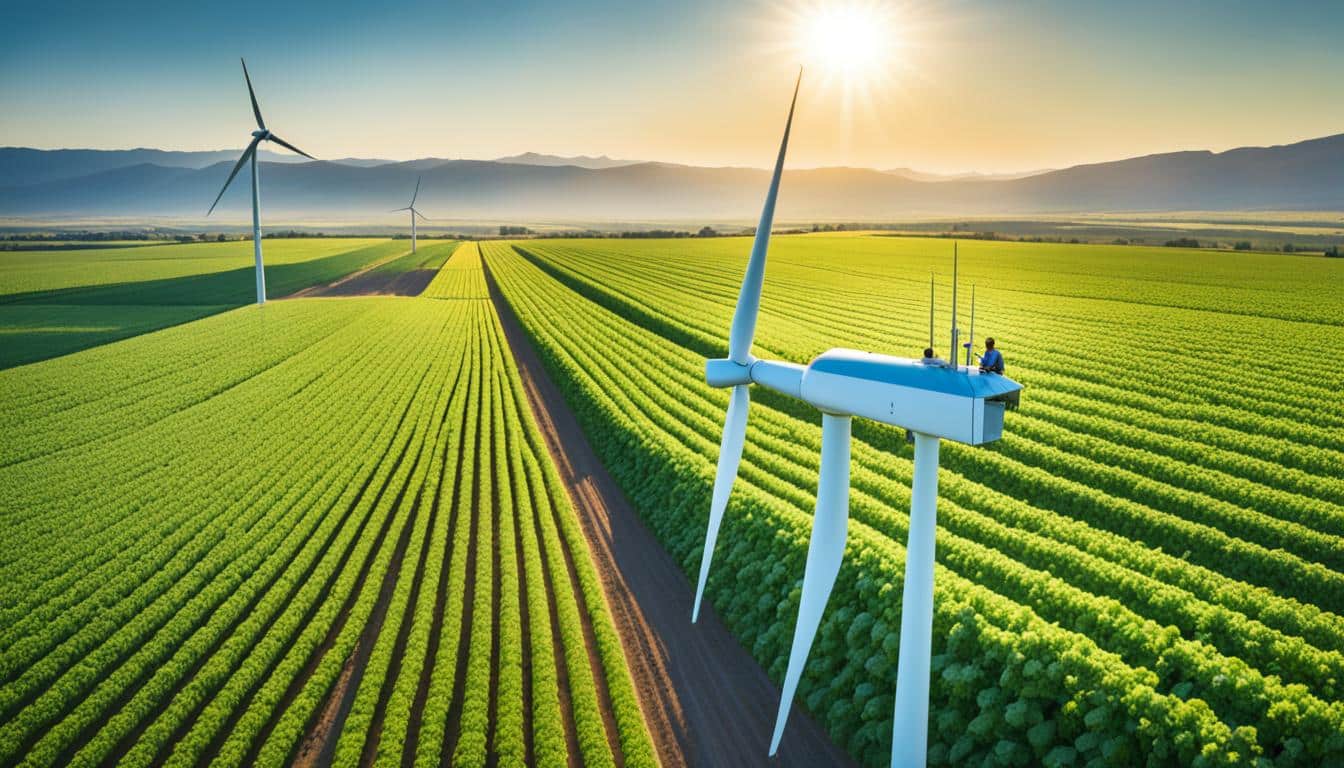
Wind and solar power are expected to grow by over a third in 2024. This growth is set to beat coal electric power for the first time. It’s a big deal for farming, offering a way to cut their carbon impact and improve how they work. More farms are using the sun, wind, and natural gases to power their operations. This fits with global goals, like those from COP28, to fight climate change.
Farmers are under pressure to move from oil and coal to green energy. This change is not just about the planet but also due to big money from food companies. These funds aim to cut methane and support farming that’s kinder to the environment. A new way called agrivoltaics is catching on fast. In the U.S., over 470 projects now use solar panels on farms. This mixing of electricity-making with farming cuts costs and brings in money from selling extra power or renting land for solar panels.
Renewable energy is key for dealing with environmental and economic challenges in agriculture. By using sustainable energy and eco-friendly methods, farmers cut down on harmful emissions. This also helps keep our planet clean.
Agriculture is a big source of greenhouse gases. Clean energy methods can lower these emissions greatly. For example, using biomass equals taking 70 million cars off the road. Solar power can also provide lots of energy without increasing global warming.
Switching to renewable energy is not just good for the planet but for wallets too. Wind energy, for instance, could create many new jobs and boost farmer’s incomes. It could also add lots of money to the US economy.
The future of farming relies on renewable energy. It helps save natural resources and makes farms more resilient to climate change. The REAP offers help with funding renewable energy projects, covering up to half the costs.
Solar and wind power offer smart ways to make farming sustainable. They ensure a bright future for agriculture, even in the face of climate challenges.
Solar power is changing how farms work, offering a clean and reliable energy source. It lets farmers use the sun to power their operations. Solar panels on barns and fields bring renewable energy directly to farms. This move reduces the need for getting power from the usual sources.
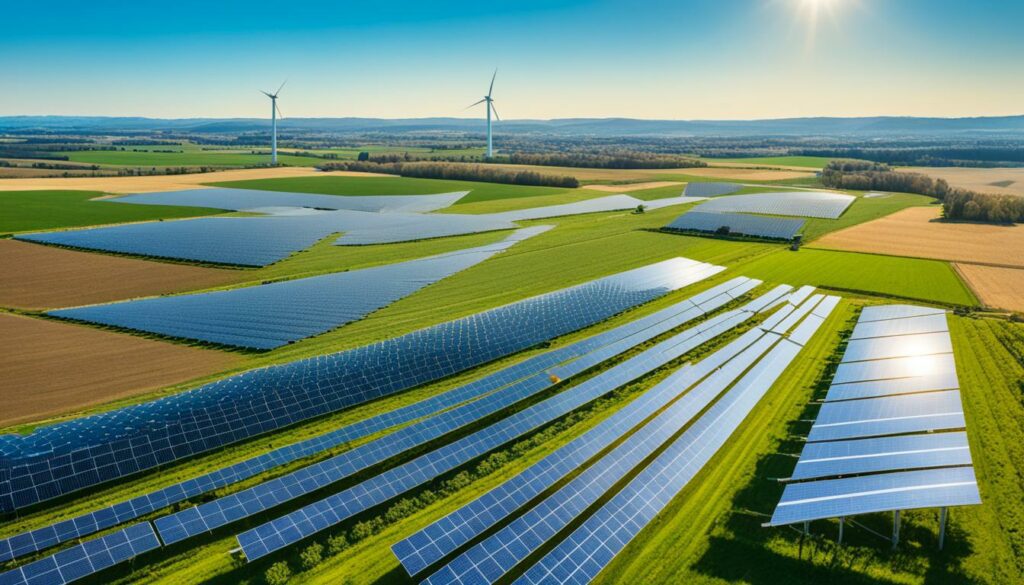
Putting up solar panels on farm buildings and open spaces is a smart move. It gives farmers their own electric power, cutting back on the need for oil and gas. By using the sun for energy, water systems can also work without extra power. This change is a big help for places where electricity isn’t easy to find.
Going solar can slash the bill for energy in a big way. It can cut costs by three-quarters for farmers, freeing up money. Adding in government help makes switching to solar even more cost-friendly. Solar power boosts crop yields, showing it’s good for both the planet and the pocket.
Many examples show that using the sun’s power on farms works well. Places with solid government rules about solar have seen big improvements. They spend less, are more energy self-sufficient, and cut down on polluting gases a lot. New solar projects have saved water by a third. These victories point to a brighter future for farming, one that’s greener and more efficient.
Wind energy in agriculture is a strong, renewable choice. It helps farms, especially those in windy areas, get electricity. Wind turbines use moving air to make power. They let farmers use less harmful energy, earn money by selling extra power.
In the United States, over 125,000 jobs come from the wind industry. This includes jobs for people fixing wind turbines, said to be the fastest-growing profession. Wind power plants in every state made over 10% of the nation’s total energy in 2022.
“Wind turbines operating in all 50 states generated more than 10% of the net total of the country’s energy in 2022.”
Putting money into new wind projects in 2022 helped the U.S. economy by $20 billion. It also made $2 billion in taxes and rent payments for local and state governments. For farmers, using wind energy goes with the trend for alternative, greener farming. It also offers a financial chance through renting land for wind turbines.
Wind energy in farming helps keep 336 million metric tons of carbon dioxide out of the air each year. This makes farming more eco-friendly. Government programs, like EQIP and REAP, help farmers get better at using energy wisely. They offer money to improve energy use after an audit.
The REAP program helps start wind energy projects by paying for half of the cost. It also offers a mix of grants and loans to cover up to 75% of the project’s cost. This makes wind power a good choice for many farms. Such help shows how important wind is for a sustainable future in farming.
Wind power may be hard to start, especially because the best wind places are often far from towns. But, it’s still one of the cheapest ways to get energy for now. It not only saves money but also supports a sustainable and steady future for agriculture.
Biofuels are proving to be a greener choice for farms. They are a part of renewable energy. Their use is changing how farms use energy and protect the environment.
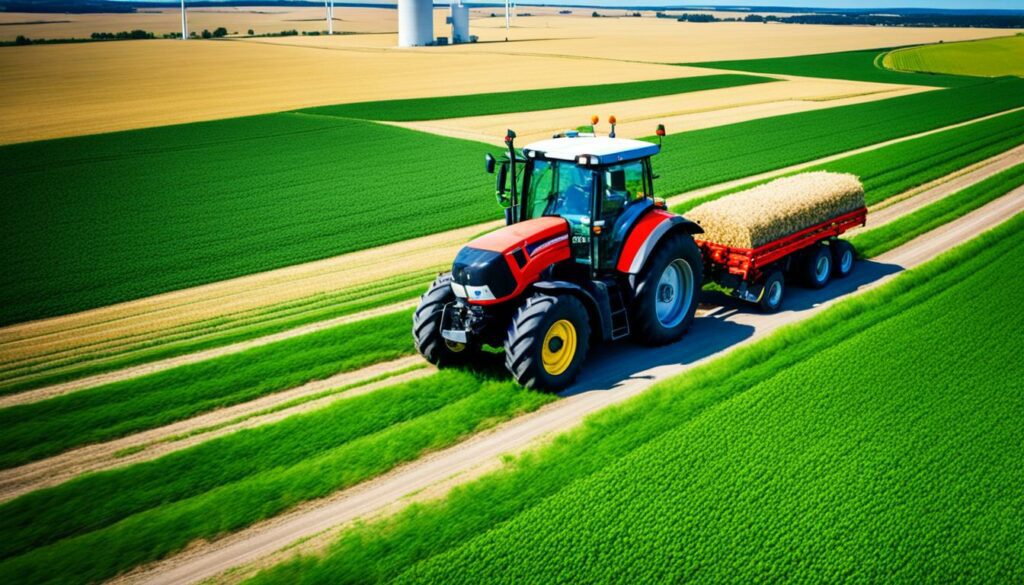
It’s important to know the types of biofuels used in farming. There’s biodiesel, which comes from things like vegetable oils. Then there’s renewable diesel that is like regular diesel but made in a greener way. Sustainable aviation fuel is also starting to be used more and more.
Biofuels can make a big economic difference for farms. They create new ways for farmers to make money. For instance, buying machines together to make biodiesel can save a lot of money. If the U.S. uses more biomass energy, it could bring about $20 billion to rural areas.
| State | Canola Acres (2021) | Biodiesel Production (Gallons) |
|---|---|---|
| Washington | 131,000 | 250,000 |
| Oregon | 7,200 | — |
| Idaho | 22,300 | — |
Biofuels are good for the planet. They cut down on harmful greenhouse gases. The USDA supports making biofuels in clean ways. This helps lower their impact on the environment. Finding new sources for biofuels, like kelp or algae, keeps moving us forward in finding eco-friendly energy.
To sum up, biofuels offer a greener, economically sound way for farming. They are key to a sustainable future for agriculture.
Agrivoltaics is a ground-breaking way to mix agriculture with solar power. It places solar panels above fields. This way, farmers can grow crops and produce energy together. This method means farmers use their land for both growing food and making energy, which is great for the environment.
The idea behind agrivoltaics is simple: put solar panels in a way that they help crops grow by creating partial shade. This is very useful for certain crops in Europe. For example, it’s good for onions and root veggies up north, and olive trees down south. The panels can be still or move, changing how much they shade the crops as needed. People are always trying to make this setup work better.
Agrivoltaics brings lots of good things. It combines making food with making electricity on the same land, making it efficient. It also cools the area around the panels, helping them work better, and sometimes helping crops grow more. For instance, using agrivoltaics can make potatoes do 20% better than usual.
This method also helps with things like letting farm machines work better and giving space for pollinators. So, it’s a complete answer to some of the hard parts of farming today.
Several places show how well agrivoltaics works, like the project “Agrophotovoltaics for a sustainable future”. In the US, the MIU Solar Power Plant blends solar power with making spaces for pollinators and trying new farming methods.
Using tools like the INSPIRE Agrivoltaics Financial Calculator makes it clear that this way of farming can be both good for the world and make money. These success stories prove that using land for solar power and farming is a win-win.
Agrivoltaics is not just a new way to use land. It’s a real step towards farming that is good for both the planet and us. It finds a way for energy and food to work together well.
Producing biogas from organic waste in farming offers a smart move towards clean energy. It changes things like manure into energy we can use, helping the environment in many ways. The manure from 200 milking cows gives off as much nitrogen as sewage from a 5,000 to 10,000 people town.
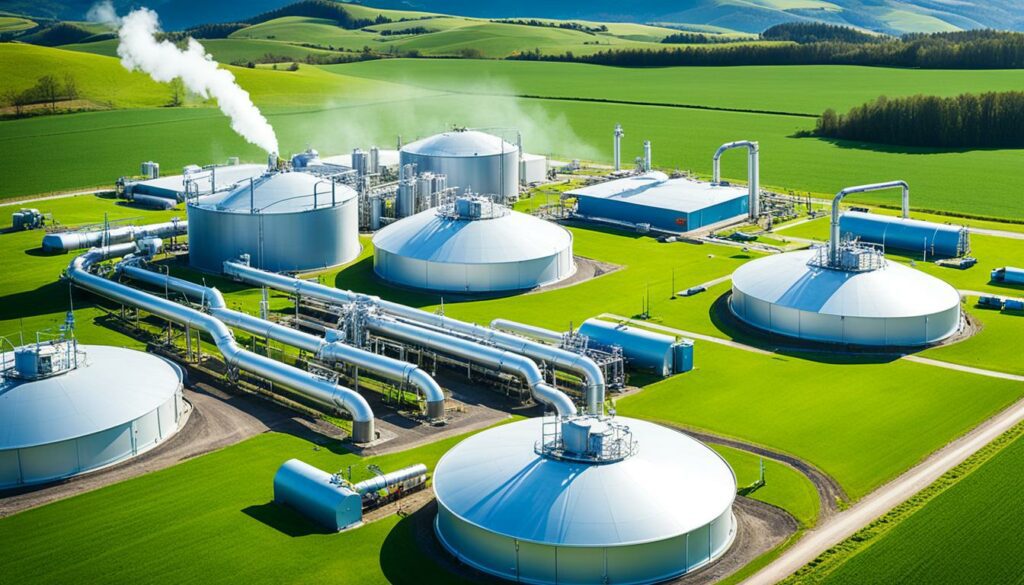
This method cuts down on harmful methane gas and bad smells from manure. It’s a better way to deal with waste. Plus, it makes good economic sense too.
AstraZeneca and Vanguard Renewables plan to power their U.S. sites with renewable gas by 2026. This goal marks a huge step in using anaerobic digestion across the country. Also, Vanguard Renewables wants to work with over 100 places by 2028.
The leftover material from this process can boost plant growth. Farms that use it have seen better crop production. Also, this process helps improve soil quality, manages nutrients better, and cuts back on harmful waste handling.
The U.S. makes more than 70 million tons of organic waste a year. There’s a big chance to do more with biogas production. Despite already using 2,200 systems, experts believe we could have over 13,500. Biogas is mostly made of methane and is a big opportunity for farms and energy use.
| Advantages of Biogas Production | Statistics |
|---|---|
| Reduction in Methane Emissions | Equivalent to annual emissions of 800,000 to 11 million passenger vehicles |
| Greenhouse Gas Emission Reduction | Compressed natural gas from biogas can reduce emissions by up to 91% relative to petroleum gasoline |
| Economic Opportunities | Potential to add over 335,000 temporary construction jobs and 23,000 permanent jobs from 13,500 new systems |
New York City is looking to gain from better use of biogas. It spends a lot every year to manage its waste. Making full use of biogas promises a greener, more self-sufficient future nationwide.
Using anaerobic digestion in farming is more than just about waste. It’s a big step towards a cleaner, economically beneficial future through biogas.
Switching to renewable energy helps cut down on carbon. It also makes farming more sustainable. To help farmers go green, governments offer different types of funding. This includes grants, tax breaks, and special programmes.
The USDA runs the REAP programme. It helps farmers set up small-scale wind projects. With $144 million in grants, it can pay for half of a project’s cost. Farmers can get up to $1 million for green energy and $500,000 for making farms more energy-efficient.
The DOE is chipping in $4 million more. This goes to help spread the use of wind tech in farming. These funds are key for getting farm tax breaks.
Tax breaks are important too. Farmers can use benefits from the PACE scheme. This offers loans from $100,000 to $50 million. The interest rates are low, between 5.0% and 7.0%. Loans can cover most of the project cost, helping farmers for many years.
Special programmes are very helpful. Focus on Energy gave over $2 million to nearly 900 farms in 2022. This led to $3.5 million in energy savings every year. Producers must get approval first to get this help. The USDA and DOE also share info through webinars. These teach about wind projects in local areas.
| Programme | Goal | Funding Available |
|---|---|---|
| REAP | Deploy smaller-scale wind projects | $144 million |
| DOE Distributed Wind Technologies | Support commercialisation | $2.5 million |
| Focus on Energy | Incentives for agribusinesses | $2 million |
Government support and funding are vital. They help speed up the use of green energy in farming. This brings good things for the economy and the earth in farming areas.
The move towards green farming methods is fast gaining ground. It combines careful use of nature with smart business choices. Solar power stands out as a top player, cutting down electricity costs by catching the sun’s energy. Wind power, with its wind turbines, offers a steady, planet-friendly supply of electricity for farms.
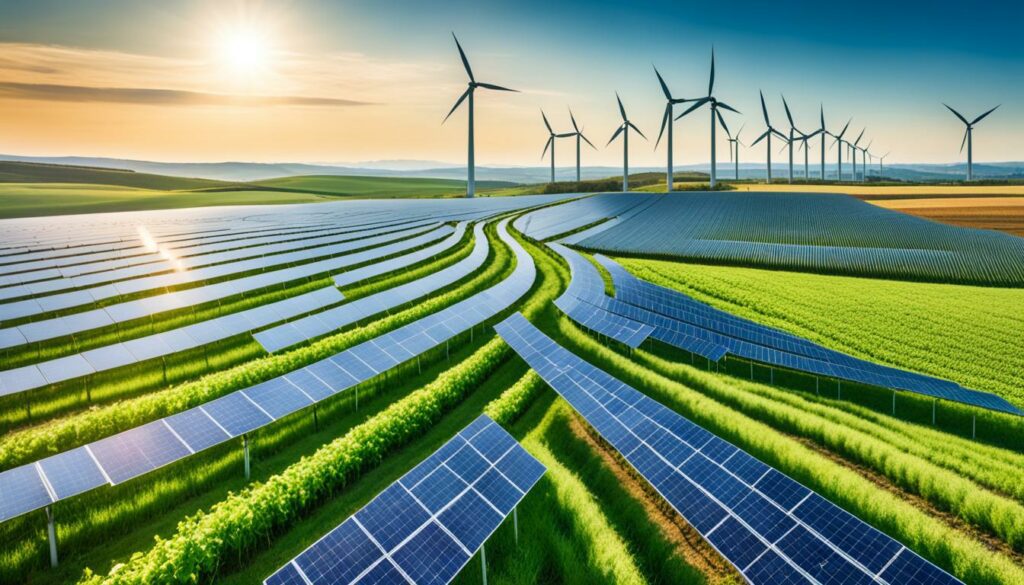
Farmers worldwide are embracing renewable energy, driven by the desire to care for the planet and save money. Programs like the Rural Energy for America Program (REAP) and the Investment Tax Credit (ITC) are helping. They provide financial aid and tax benefits to those adopting solar systems and other sustainable methods, making them more affordable.
The future looks bright for green farming, thanks to new tech and growing understanding of the benefits of renewable energy. Systems like solar panels and wind turbines not only slash energy costs and lessen the need for harmful fossil fuels but also offer financial gains through excess energy sales. These eco-friendly choices also reduce pollution and improve a farm’s public image.
But it’s not all easy. Switching to sustainable farming faces hurdles like big startup costs and local and federal rules. Tackling these challenges calls for careful money management, understanding the law, and picking the right energy solutions for each farm. Yet, the rewards, such as a more sustainable farm, saving resources, and the ability to keep going even when the grid fails, make the effort worth it.
The turn to renewable energy in farming is more than a passing trend; it’s necessary for a better tomorrow. As we move forward, there will be tough times and great chances to build a sustainable agricultural future together.
New tech is making farmers use more renewable energy. At the Commodity Classic 2024, which Association of Equipment Manufacturers sponsors, we saw how. Precision farming, using things like GPS tractors and drones, is boosting farm efficiency. This means farmers can save money and grow more crops.
The Internet of Things (IoT) is also a game-changer in farming. It allows for real-time monitoring of equipment. This makes farming more efficient. IoT also helps in fixing machines before they break. All this is key in using more renewable energy in farming.
There’s a big push for farming gear to be both efficient and kind to the planet. Smart machines can check on soil, weather, and crops. They help farmers make better choices.
Adding robots and automatic machines to farms is cutting down on hard work. Companies are working together to introduce new tech solutions.
With AI, machine learning, and more, the future of farming looks bright. These new technologies are making farming not just better but more sustainable. They’re also helping use more renewable energy.
| Adoption Aspect | Impact |
|---|---|
| Precision Farming Technologies | Optimised resource utilisation, increased yields, reduced input costs |
| IoT Integration | Real-time monitoring, data collection, improved operational efficiency |
| Predictive Maintenance | Minimal machinery downtime, ensured peak performance |
| Smart Equipment | Data-driven insights on soil health, crop conditions, machinery performance |
| Robotics and Automation | Streamlined labour-intensive tasks, improved efficiency |
| AI & Machine Learning Integration | Advanced decision-making, autonomous systems, vertical farming |
By using renewable energy and new farming tech, the farming sector can grow. It can meet future needs without harming the environment.
Large-scale farms can change the way we use energy by adopting clean technology. They use wind and solar farms to fight climate change. These efforts also create new ways to earn money, which help during ups and downs of the market.
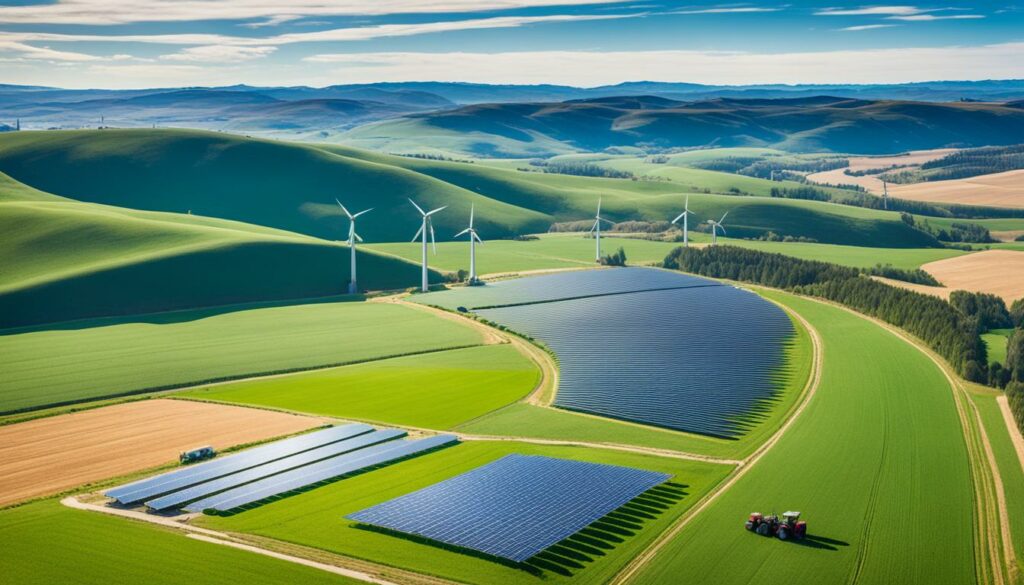
Wind and solar power are key in making farming greener. Wind turbines turn wind into electricity, especially in windy areas. Solar panels help farms cut their electricity costs. These technologies make farming sustainable and allow farms to sell extra electricity back to the grid.
Using energy wisely in agriculture is very important. Special systems check and manage how energy is made and used. This smart energy use lowers costs and increases benefits from using renewables. It’s a clever way to keep large farms sustainable.
Renewable energy helps farmers earn money in new ways. They can rent land for solar panels or sell extra power. This extra income helps them withstand market changes and bad weather. It improves their finances and helps the planet too.
| Renewable Energy Type | Initial Investment | Annual Savings | Payback Period | Lifespan |
|---|---|---|---|---|
| Solar Power | $18,000 – $25,000 | Up to 85% in heating costs for dairy farms | 5-10 years | 25-30 years |
| Wind Power | $13,000 – $40,000 | Varies by region | 5-10 years | 20-25 years |
| Biofuels | $400 – $13,000 (for oil presses) | Varies by production scale | 5-10 years | — |
Renewable farming significantly reduces the environmental impact. By switching to clean energy, farms lower carbon emissions and boost biodiversity. State environmental agencies, like the Department of Environmental Protection (DEP), support this change. They offer programmes such as the Agriculture Energy Efficiency Rebate and the Small Business Advantage Grant. These help farms go green and lessen pollution.
I deeply believe the advantages go further than just less pollution. The Environmental Quality Incentives Programme, part of the On-Farm Energy Initiative by the Natural Resource Conservation Service (NRCS), helps. It supports farmers in buying and setting up energy-saving equipment. This, along with sustainable farming, helps the environment thrive and keeps farms strong.
A big portion of global energy goes to farming, and it’s a major source of emissions. Using renewable energy can cut this huge impact. The Rural Energy for America Programme (REAP), powered up by the Inflation Reduction Act, is key here. It lets farmers mix grants and loans. This way, they can cover up to 75% of the costs and slowly switch to renewable energy.
Renewable energy efforts are key in supporting plant and animal life variety. They lessen farm dependency on harmful sources. This ‘green’ farming not only fights climate change but also makes farms more resilient and productive. It shows how much our environment gains from farming with clean energy.
Using renewable energy on farms is a big step towards being more sustainable. There are challenges along the way. But if addressed, farms can easily move to greener options. I’ll look into these obstacles and how farmers can beat them to reach a sustainable future.
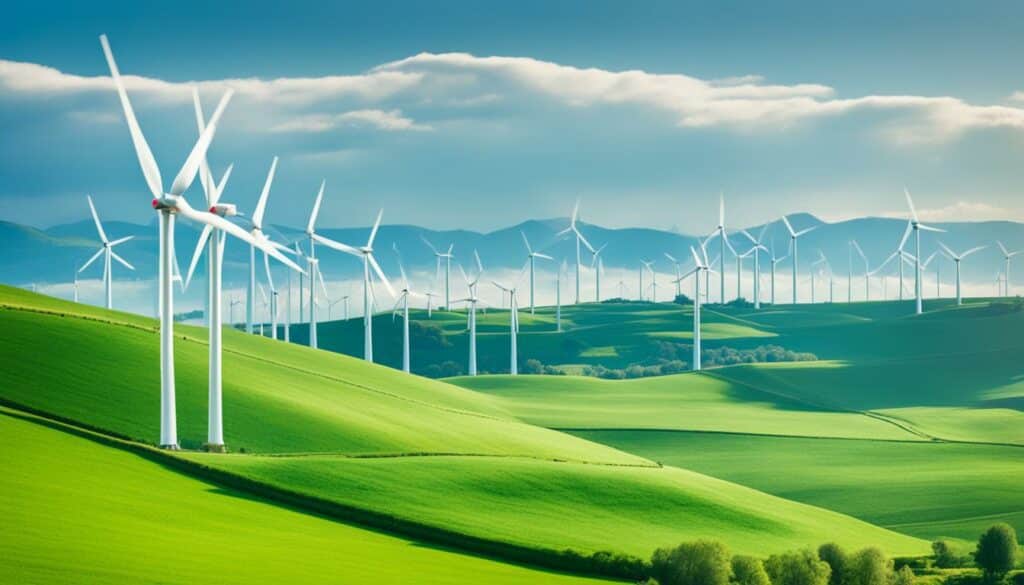
One main issue is the big money needed to start using renewable energy on farms. Getting enough money to begin these projects is tough for farmers. They know they can save a lot in the long run. But the first costs are hard to bear. Getting the right funding for green projects is key. Things like low-interest loans, grants, and subsidies can help make renewable energy doable for farms.
Switching to renewable energy means big changes in how farms are set up and run. This includes adding solar panels, wind turbines, or biogas plants. It takes a lot of know-how. The speed at which new tech is used depends on how well it’s introduced. Training, and having a skilled team, is vital to tackle these tech issues.
The rules and policies in place can help or hinder using more renewable energy on farms. Even though more countries are setting goals for renewable energy, blocking rules are still a problem. People might not like the change because of wrong ideas or fears about the environment. We can fight these rules by pushing for better policies and teaching people more about renewable energy.
| Barrier | Solution |
|---|---|
| Cost and Financing | Low-interest loans, grants, subsidies |
| Technical and Infrastructure | Training, skilled workforce development |
| Policy and Regulatory | Supportive policies, public awareness campaigns |
We can beat the problems stopping us from using more renewable energy. It takes working on the money, tech, and rules. Doing this can help farms be more eco-friendly and also do better in their business.
Making the switch to renewable energy in farming is more than just using new tech. It’s about planning well, choosing the right tools, and putting those choices into action. I’ve learned that these ways are key to making farming both friendly to the earth and smart for business.
Creating a solid plan and checking what you need are the first steps. You must look at what your farm needs, how much energy it uses now, and what green power sources you can use. Things like energy checks show where you can improve. Knowing your land and climate helps pick the best green energy options.
Picking the best green tech depends on the size of your farm and what resources you have. For example, solar panels are easy to use and can cut your power bills by a lot. Windmills work great if your farm gets lots of wind, and you can even sell extra power. And, green fuels like biodiesel and ethanol cut down on using oil.
Getting green tech working smoothly on your farm needs smart plans. Starting with small tests can show how well things work and if they can grow. This helps you use your money and stuff well. Also, using help from big programs and local deals can make the change easier on your wallet. Trying out new green ways step by step means you can fix things as you go and do better in the long run.
The table below highlights essential data and incentives available to farmers:
| Renewable Technology | Key Benefits |
|---|---|
| Solar Power | Cost-effective, significant reduction in electricity bills, Investment Tax Credit (ITC) |
| Wind Energy | Consistent power supply, job creation, annual land lease income |
| Biofuels | Environmentally friendly, reduces fossil fuel dependence, supported by USDA programs |
Switching to green energy is about securing farms for the future. It’s not just about the planet but also about staying strong financially. Following the right steps can make your farm both green and successful.
The future of farming is changing. It’s all about moving to ways that are good for the Earth. This means using technology that won’t harm our planet. About 30% of the world’s energy goes into farming. But, if farmers switch to renewable energy, they can cut down on harmful gases. Plus, it will save them money.
Yet, getting to full green farming faces some big challenges. There’s not enough money for new green farming tech. Many smart minds are needed to solve these problems, but not everyone is giving them what they need to succeed. Even so, there’s hope in things like the sun’s energy. It’s almost everywhere and it’s free. But, it comes and goes, and not all places can use it well.
Mixing different green power types and using more renewable sources helps. This is especially good for farms in far-off places in poor countries. It can make farming better and the food we get tastier and healthier. Putting green tech in farming is key for our economy and the Earth. By working together, we can make farming’s future bright and strong.
Renewable energy helps farming in many ways. It reduces carbon emissions and cuts costs. It also makes sure farming can carry on for the long run. This all helps our planet’s health too.
Solar power is great for farms. It saves a lot of money, makes farms more independent, and can earn extra cash. With solar panels on the land and buildings, farms turn sunlight into energy. This way of farming is kind to our environment.
Wind energy works well for farms in windy places. It lowers emissions and bills, and sells extra energy for money. This green approach helps farming in a complete way.
Biofuels come from crops and offer a green option to regular fuels. They help farms make more money and cut down on harmful emissions. This is good for the planet.
Agrivoltaics combines solar power with farming, using land for both. It shields crops and animals from too much sun, saving water and improving growth. It’s a smart and efficient way to farm.
Biogas turns waste into energy using a special process. It creates power and a natural fertiliser. This is great for the earth and cuts down on farming costs.
Many governments give help like grants and tax breaks to push renewable energy in farming. Programs such as REAP and EQIP ease the switch for farmers.
Renewable energy is getting more common in farming, thanks to its benefits. It’s set to grow with new technology and more people knowing about it. Tackling cost and policy issues will open big doors.
Technology is changing how farming uses renewable energy. New solar tech and smart systems cut costs and help the environment. They’re vital for making the farming sector greener.
Big farms can earn a lot from solar and wind energy. Managing this energy well boosts profits and helps the planet too. It’s a smart move in an up-and-down market.
Moving to clean energy means less pollution and smaller carbon footprints. It also helps nature to thrive. Sustainable farming powered by green energy is good for everyone.
There are hurdles like cost and tech issues, plus rules to follow. Farmers can beat these obstacles with smart financing, knowledge, and good support from policies. Then, using green power becomes easy for everyone.
Planning well, choosing the right tech for each farm, and then moving step by step are key. This ensures that renewable energy fits well and grows within farming. It’s all about doing it smartly.